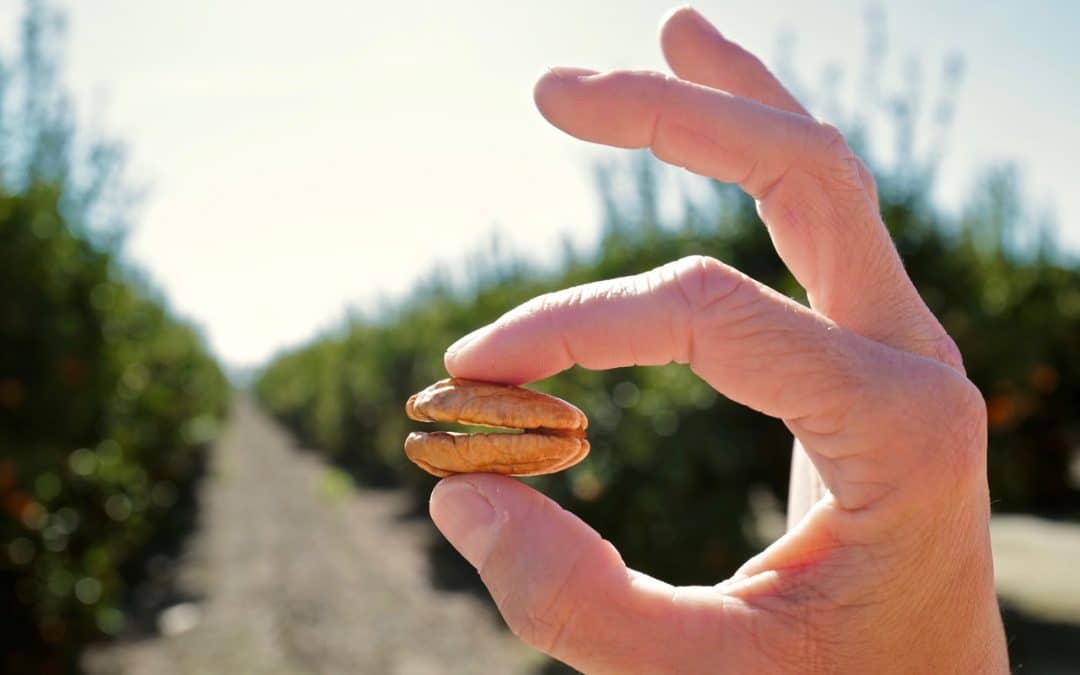by Larry Aylward – Meister Media
Four years ago, an Arizona-based pecan tree grower needed a foliar potassium product to help maintain his expansive crop. Problem was, he didn’t know of any worthwhile foliar potassium products that his suppliers offered.
“There were a lot of poor formulations out there,” the grower says.
While the grower was applying potassium to the soil through irrigation, it wasn’t enough. “Our crops needed the added foliar potassium for fruit set,” he stresses.
In 2018, the grower, who tends to about 10,000 acres of pecan trees, heard about a product from Dinuba, Calif.-based Nutrient TECH called Hi-K, which contains 28% soluble potash, a common source of potassium. Hi-K is also fueled by Nutrient TECH’s proprietary, multi-component technology SimplyFLO, which enhances potassium delivery by allowing for better dispersion and nutrient absorption.
After applying Hi-K, it didn’t take long for the grower to see beneficial results. From a physical standpoint, the overall nut fill and quality of the pecans improved, a result of the grower being able to get the crop’s nitrogen-potassium ratio back in coordination.
“It’s important to have the nitrogen-potassium ratio at 2 to 1 nitrogen, and our ratio had not been at 2 to 1,” the grower says. “We were always off.”
But not anymore. Since applying Hi-K twice a year – one-half gallon an acre early in the season and one-half gallon an acre midway through the season – the ratio is back to where it should be.
Filling a Need
Hi-K, which debuted in the late 1990s, is one of Nutrient TECH’s top-selling products. Looking back nearly 25 years ago, Chris Reimche, production plant manager for Nutrient TECH and a chemist who helped develop the product, says there was a need for a potassium product like Hi-K, specifically for stone fruit, apples, grapes, and tree nuts. Hi-K also contains 26% phosphorus, which Reimche says provides “a big part of the energy mechanism” in Hi-K.
“A label often doesn’t tell the whole story of a product, and not all potassium products are the same,” Reimche says. “We worked hard to develop a balanced and unique combination of potassium phosphate in Hi-K along with our SimplyFLO technology.”
Traditionally, growers have used potassium carbonate solution (0-0-30), which has been around for decades. But Reimche says potassium carbonate’s high pH can affect the internal workings of plants.
“We just felt there was an opportunity to do it better with Hi-K,” Reimche adds. “As with all our micronutrients, we try to be unique and extremely effective, and so that’s how Hi-K became what Hi-K is. Plus, it is unique as a soluble solution. It’s a clear formulation but extremely heavy with a lot of nutrients packed in it.”
Worth the Investment
When Hi-K arrived on the market, growers experienced sticker shock with the product’s price, Reimche recalls. “They thought it was expensive, and that they could purchase a cheap commodity product instead,” he adds.
But when the growers who decided to try the product began to see the results and return on investment that Hi-K offered, the sticker shock dissipated, Reimche says.
“Growers realized there wasn’t any other product on the market like it,” he adds.
The Arizona pecan tree grower says he has never considered Hi-K too expensive, saying it costs as much as competing products that don’t perform nearly as well.
Jason Howe, Nutrient TECH’s Territory Sales Manager for Arizona and Southern California, says more pecan tree growers in his territory have turned to Hi-K to improve their crops. Most prefer to spray Hi-K twice a year “so trees don’t have to work hard to find potassium” when they need it.
Howe says the pecan tree growers are impressed with the improved quality and heavier nuts they can grow since implementing Hi-K in their operations. But tree nut growers aren’t the only farmers using Hi-K. Reimche says California wine grape growers use Hi-K late in the season to increase brix (sugar content of an aqueous solution) development. Many have used Hi-K for years and aren’t only pleased with the results but also that the potassium boost doesn’t affect acid balance in the grapes, Reimche adds.
“Wine growers can raise the sugar without any adverse effect,” he says, noting that some potassium products can affect acid balances. “So late-season potassium use for sugar development in the wine industry has been a good role for Hi-K.”
Hi-K is also used to boost potassium in stone fruit and apples. Several years ago, Reimche traveled to a Costa Rica-based research facility and tested Hi-K with pineapple growers, who had been using potassium chloride, another older commodity product, to provide potassium uptake.
“They were able to replace 50 pounds of potassium chloride an acre with 2 quarts of Hi-K an acre and get the same response,” Reimche says, noting the growers were astonished with the positive results that Hi-K caused in their pineapple crop.
Even though Hi-K is well into its third decade, it’s as relevant as ever.
“It was exciting to develop it and get it to where it is today,” Reimche says. “We continue to work to improve it, which we do with all our products.”



